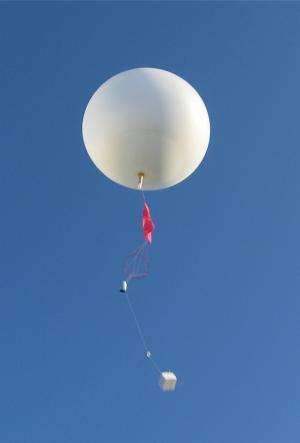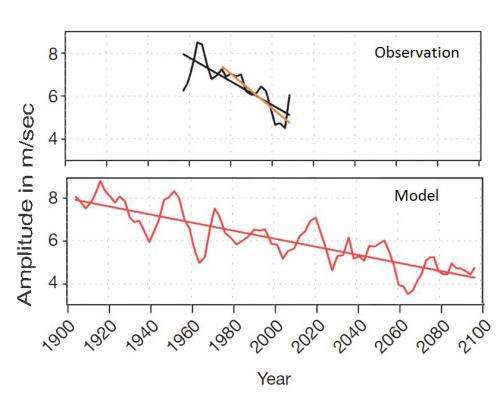The tropical upper atmosphere 'fingerprint' of global warming

In the tropics at heights more than 10 miles above the surface, the prevailing winds alternate between strong easterlies and strong westerlies roughly every other year. This slow heartbeat in the tropical upper atmosphere, referred to as the quasibiennial oscillation (QBO), impacts the winds and chemical composition of the global atmosphere and even the climate at Earth's surface.
The pulse of the QBO has weakened substantially at some altitudes over the last six decades, according to a new study by scientists at the International Pacific Research Center, University of Hawaii at Manoa, and the Japan Agency for Marine-Earth Science and Technology. The decline in the strength of the QBO is consistent with computer model projections of how the upper atmosphere responds to global warming induced by increased greenhouse gas concentrations. The study appears in the May 23, 2013, online issue of Nature.
"This is the first demonstration of a systematic long-term trend in the observed QBO record," says co-author Kevin Hamilton and Director of the IPRC. "We see a similar trend in computer models of the global atmosphere when they simulate the last century using the historical changes of greenhouse gases. So this change in upper atmospheric behavior can be considered part of the "fingerprint" of the expected global warming signal in the climate system."
The global atmospheric circulation is characterized by air slowly rising in the tropics into the upper atmosphere and sinking at higher latitudes. While this circulation is so slow that a blob of air may take decades to travel to the upper atmosphere, it impacts the chemical composition of the global atmosphere because many chemical properties are very different in the lower and upper atmosphere layers. Although computer models used to project climate changes from increasing greenhouse gas concentrations consistently simulate an increasing upward airflow in the tropics with global warming, this flow cannot be directly observed.

"We demonstrated that the mean upward-air motion suppresses the strength of the QBO winds in the models and thus interpret our observed weakened QBO trend as confirmation that the mean upward velocity in the tropics has indeed been increasing," notes Hamilton.
Hamilton provides an example of why the upward airflow is so significant: "The manufacture of ozone-destroying chemicals such as the freon compounds used in the past in spray cans and in refrigerators has been largely banned for over 20 years. These chemicals, however, remain in the atmosphere for many decades. They are slowly flushed out of the lower atmosphere into the upper atmosphere where they are destroyed. Stronger mean upward airflow transports these chemicals more quickly into the upper atmosphere, and the ozone layer will recover more quickly to its natural state before the introduction of man-made freon compounds."
More information: Yoshio Kawatani and Kevin Hamilton, Weakened stratospheric quasibiennial oscillation driven by increased tropical mean upwelling. Nature, volume 497, issue 7450, pp 478–481 DOI: 10.1038/nature12140
Journal information: Nature
Provided by University of Hawaii at Manoa




















